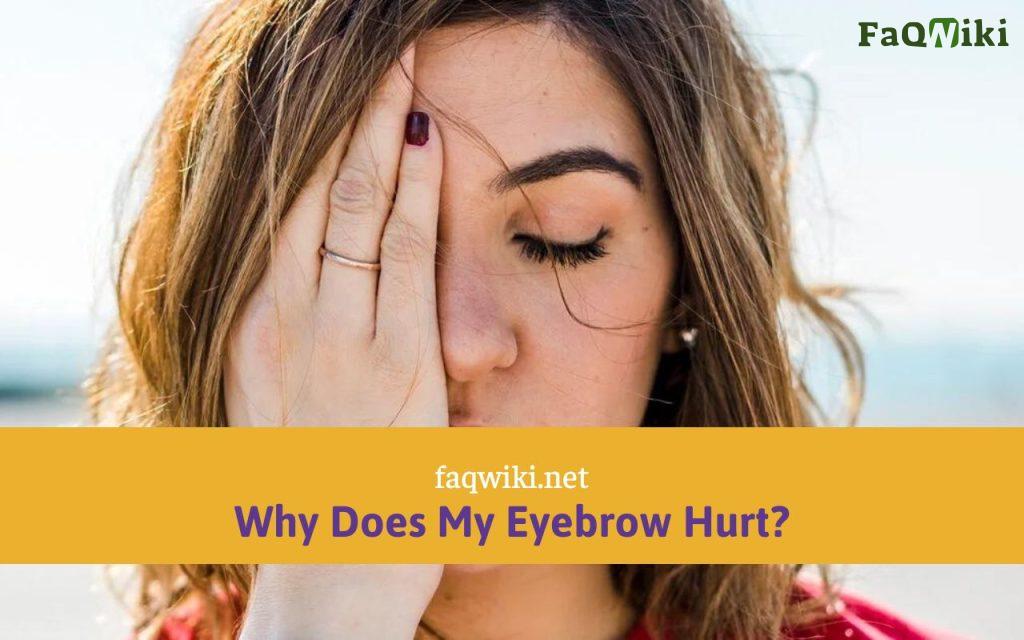Why Does My Eyebrow Hurt?

Eyebrow pain can be a nuisance that affects daily life and makes simple activities like opening and closing the eyes uncomfortable. It is important to understand the causes of eyebrow pain to address the underlying issue. In this article, we will delve into the common and less common causes of eyebrow pain, diagnosis, treatment, prevention, and self-care.
Common Causes of Eyebrow Pain
Eyebrow injury or trauma
Sports-related injuries or accidents can cause eyebrow pain. Eyebrows are prone to injuries because they protrude from the forehead and lack protection. The injury could be as a result of being hit by a ball or a sudden impact. A person can also develop eyebrow pain if they accidentally scratch or pierce the skin while plucking or shaping the eyebrows.

Skin conditions
Acne, eczema, and psoriasis are common skin conditions that can cause eyebrow pain. Acne occurs when hair follicles become clogged with oil and dead skin cells. Eczema is a condition where the skin becomes inflamed, itchy, and red. Psoriasis is a chronic autoimmune condition that causes the skin to become dry, itchy, and flaky. These skin conditions can affect the eyebrows and cause pain and discomfort.
Sinus infections
Sinusitis is a common condition that causes inflammation of the sinus cavities. The sinuses are located around the eyes and forehead, and when they become inflamed, they can cause pain and pressure in the eyebrows. Sinusitis is usually caused by viral or bacterial infections, allergies, or environmental irritants.
Eye infections
Eye infections such as conjunctivitis and styes can cause eyebrow pain. Conjunctivitis is an inflammation of the eye that causes redness, swelling, and discharge. Styes are red, painful lumps that form on the eyelids. These conditions can cause discomfort around the eyebrows and eyes.
Eyebrow threading or waxing
Eyebrow hair removal techniques like threading and waxing can cause eyebrow pain. These techniques involve pulling out the hair from the root, which can be painful. The skin around the eyebrows can also become red and inflamed, causing pain and discomfort.
Less Common Causes of Eyebrow Pain
Trigeminal neuralgia: Trigeminal neuralgia is a condition that affects the trigeminal nerve, which is responsible for sensation in the face. It causes severe facial pain that can be triggered by even mild stimuli like touching the face. The pain can radiate to the eyebrows and cause discomfort.
Migraines or tension headaches: Migraines and tension headaches can cause pain and discomfort around the eyebrows. Migraines are severe headaches that are often accompanied by visual disturbances, nausea, and sensitivity to light and sound. Tension headaches are less severe than migraines but can cause a constant ache around the eyebrows and forehead.
Cluster headaches: Cluster headaches are rare but severe headaches that cause excruciating pain around the eye, temple, and forehead. The pain can last from 15 minutes to three hours and can be accompanied by tearing, redness, and swelling around the eye. Cluster headaches occur in cycles and can recur several times a day for weeks or months.
Temporal arteritis: Temporal arteritis is a condition that causes inflammation of the blood vessels in the head and neck. It is common in people over 50 years and can cause severe headache, jaw pain, and vision problems. It can also cause pain around the eyebrows and forehead.
Brain tumors: Brain tumors can cause eyebrow pain as a result of pressure on the nerves around the eyes. Brain tumors can be benign or malignant, and they can cause a variety of symptoms, including headaches, seizures, and vision problems.
Diagnosis and Treatment
It is important to seek medical advice for persistent eyebrow pain, especially if it is accompanied by other symptoms such as fever, vision changes, or neurological symptoms. A doctor will conduct a physical examination and ask about the patient’s medical history and symptoms. They may also order diagnostic tests such as imaging tests (CT scan or MRI) or blood tests.
The treatment for eyebrow pain will depend on the underlying cause. For mild cases, over-the-counter pain relievers such as acetaminophen or ibuprofen can provide relief. For more severe cases, prescription pain relievers or corticosteroids may be prescribed. Antibiotics may be prescribed for bacterial infections. In the case of skin conditions like eczema or psoriasis, topical creams or ointments may be recommended. For eye infections, antibiotics or antiviral medication may be prescribed. In severe cases of trigeminal neuralgia or temporal arteritis, surgery may be required.
Self-care measures can also help alleviate eyebrow pain. Warm compresses applied to the eyebrows can provide relief for sinusitis or styes. Keeping the sinuses hydrated with saline nasal spray can also be helpful. Avoiding triggers like allergens or environmental irritants can prevent sinusitis and other infections. Avoiding eyebrow hair removal techniques like threading or waxing can also prevent pain and discomfort.
Prevention
Preventing eyebrow pain involves taking care of the eyebrows and avoiding activities that can cause injury or irritation. Avoiding harsh chemicals and makeup around the eyebrows can prevent skin irritation. Proper hygiene practices like washing the hands and avoiding touching the face can prevent infections. Using proper sports gear like helmets and eye protection can prevent sports-related injuries. Avoiding plucking or shaping the eyebrows excessively can prevent injury to the skin around the eyebrows.
Conclusion
Eyebrow pain can be a symptom of various underlying conditions ranging from skin conditions to serious medical conditions like brain tumors. It is important to seek medical advice for persistent eyebrow pain, especially if it is accompanied by other symptoms. Proper diagnosis and treatment can provide relief and prevent complications. Self-care measures and prevention can also help alleviate eyebrow pain. By understanding the causes, diagnosis, treatment, and prevention of eyebrow pain, individuals can take proactive steps to prevent and manage the condition.
